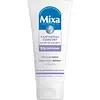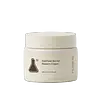What's inside
What's inside
 Key Ingredients
Key Ingredients

 Benefits
Benefits

 Concerns
Concerns

 Ingredients Side-by-side
Ingredients Side-by-side

Water
Skin ConditioningDimethicone
EmollientHydrogenated Polyisobutene
EmollientButyrospermum Parkii Butter
Skin ConditioningGlycerin
HumectantButylene Glycol
HumectantPropanediol
SolventCetyl PEG/PPG-10/1 Dimethicone
EmulsifyingAluminum Starch Octenylsuccinate
AbsorbentHelianthus Annuus Seed Oil
EmollientTrihydroxystearin
Skin ConditioningPolyglyceryl-4 Isostearate
EmulsifyingAlcohol
AntimicrobialBHT
AntioxidantCaprylyl Glycol
EmollientCitric Acid
BufferingDisodium EDTA
Magnesium Sulfate
Panthenol
Skin ConditioningPentaerythrityl Tetra-Di-T-Butyl Hydroxyhydrocinnamate
AntioxidantPhenoxyethanol
PreservativeRibes Nigrum Seed Oil
EmollientRosa Canina Fruit Oil
EmollientSodium Phytate
Tocopherol
AntioxidantWater, Dimethicone, Hydrogenated Polyisobutene, Butyrospermum Parkii Butter, Glycerin, Butylene Glycol, Propanediol, Cetyl PEG/PPG-10/1 Dimethicone, Aluminum Starch Octenylsuccinate, Helianthus Annuus Seed Oil, Trihydroxystearin, Polyglyceryl-4 Isostearate, Alcohol, BHT, Caprylyl Glycol, Citric Acid, Disodium EDTA, Magnesium Sulfate, Panthenol, Pentaerythrityl Tetra-Di-T-Butyl Hydroxyhydrocinnamate, Phenoxyethanol, Ribes Nigrum Seed Oil, Rosa Canina Fruit Oil, Sodium Phytate, Tocopherol
Avena Sativa Protein Extract
Skin ConditioningDimethicone
EmollientGlycerin
HumectantSqualane
EmollientHydrogenated Polydecene
Emollient1,2-Hexanediol
Skin ConditioningCetyl PEG/PPG-10/1 Dimethicone
EmulsifyingButylene Glycol
HumectantPropanediol
SolventButyrospermum Parkii Butter
Skin ConditioningTapioca Starch
Avena Sativa Kernel Protein
Skin ConditioningSimmondsia Chinensis Seed Oil
EmollientTheobroma Cacao Extract
Skin ConditioningMacadamia Integrifolia Seed Oil
Skin ConditioningOat Amino Acids
Skin ConditioningBifida Ferment Lysate
Skin ConditioningPanthenol
Skin ConditioningMagnesium Sulfate
Water
Skin ConditioningCaprylyl Glycol
EmollientCyclopentasiloxane
EmollientEthylhexylglycerin
Skin ConditioningPentylene Glycol
Skin ConditioningLauryl Polyglyceryl-3 Polydimethylsiloxyethyl Dimethicone
Skin ConditioningTrisodium Ethylenediamine Disuccinate
Beta-Sitosterol
Emulsion StabilisingAluminum Hydroxide
EmollientPolyglyceryl-10 Stearate
Skin ConditioningTriethoxycaprylylsilane
Dextrin
AbsorbentHydrogenated Lecithin
EmulsifyingPolyhydroxystearic Acid
EmulsifyingAluminum Sucrose Octasulfate
Skin ConditioningBrassica Campestris Sterols
EmollientCholesterol
EmollientHydroxyphenyl Propamidobenzoic Acid
Skin ConditioningPhytosteryl/Behenyl/Octyldodecyl Lauroyl Glutamate
Skin ConditioningPolyglyceryl-10 Oleate
Skin ConditioningNeopentyl Glycol Diethylhexanoate
EmollientSodium Surfactin
CleansingCellulose
AbsorbentPentaerythrityl Tetra-Di-T-Butyl Hydroxyhydrocinnamate
AntioxidantTriisopropanolamine
BufferingAscorbyl Palmitate
AntioxidantTocopherol
AntioxidantDisodium EDTA
Titanium Dioxide
Cosmetic ColorantAvena Sativa Protein Extract, Dimethicone, Glycerin, Squalane, Hydrogenated Polydecene, 1,2-Hexanediol, Cetyl PEG/PPG-10/1 Dimethicone, Butylene Glycol, Propanediol, Butyrospermum Parkii Butter, Tapioca Starch, Avena Sativa Kernel Protein, Simmondsia Chinensis Seed Oil, Theobroma Cacao Extract, Macadamia Integrifolia Seed Oil, Oat Amino Acids, Bifida Ferment Lysate, Panthenol, Magnesium Sulfate, Water, Caprylyl Glycol, Cyclopentasiloxane, Ethylhexylglycerin, Pentylene Glycol, Lauryl Polyglyceryl-3 Polydimethylsiloxyethyl Dimethicone, Trisodium Ethylenediamine Disuccinate, Beta-Sitosterol, Aluminum Hydroxide, Polyglyceryl-10 Stearate, Triethoxycaprylylsilane, Dextrin, Hydrogenated Lecithin, Polyhydroxystearic Acid, Aluminum Sucrose Octasulfate, Brassica Campestris Sterols, Cholesterol, Hydroxyphenyl Propamidobenzoic Acid, Phytosteryl/Behenyl/Octyldodecyl Lauroyl Glutamate, Polyglyceryl-10 Oleate, Neopentyl Glycol Diethylhexanoate, Sodium Surfactin, Cellulose, Pentaerythrityl Tetra-Di-T-Butyl Hydroxyhydrocinnamate, Triisopropanolamine, Ascorbyl Palmitate, Tocopherol, Disodium EDTA, Titanium Dioxide
 Reviews
Reviews

Ingredients Explained
These ingredients are found in both products.
Ingredients higher up in an ingredient list are typically present in a larger amount.
Butylene Glycol (or BG) is used within cosmetic products for a few different reasons:
Overall, Butylene Glycol is a safe and well-rounded ingredient that works well with other ingredients.
Though this ingredient works well with most skin types, some people with sensitive skin may experience a reaction such as allergic rashes, closed comedones, or itchiness.
Learn more about Butylene GlycolThis ingredient is also known as shea butter. It is an effective skin hydrator and emollient.
Emollients help soothe and soften your skin. It does this by creating a protective film on your skin. This barrier helps trap moisture and keeps your skin hydrated. Emollients may be effective at treating dry or itchy skin.
Shea butter is rich in antioxidants. Antioxidants help fight free-radicals, or molecules that may harm the body. It is also full of fatty acids including stearic acid and linoleic acid. These acids help replenish the skin and keep skin moisturized.
While Shea Butter has an SPF rating of about 3-4, it is not a sunscreen replacement.
Shea butter may not be fungal acne safe. We recommend speaking with a professional if you have any concerns.
Learn more about Butyrospermum Parkii ButterCaprylyl Glycol is a humectant and emollient, meaning it attracts and preserves moisture.
It is a common ingredient in many products, especially those designed to hydrate skin. The primary benefits are retaining moisture, skin softening, and promoting a healthy skin barrier.
Though Caprylyl Glycol is an alcohol derived from fatty acids, it is not the kind that can dry out skin.
This ingredient is also used as a preservative to extend the life of products. It has slight antimicrobial properties.
Learn more about Caprylyl GlycolThis ingredient is a high molecular weight silicone. It has emulsifying and skin conditioning properties.
Dimethicone is a type of synthetic silicone created from natural materials such as quartz.
What it does:
Dimethicone comes in different viscosities:
Depending on the viscosity, dimethicone has different properties.
Ingredients lists don't always show which type is used, so we recommend reaching out to the brand if you have questions about the viscosity.
This ingredient is unlikely to cause irritation because it does not get absorbed into skin. However, people with silicone allergies should be careful about using this ingredient.
Note: Dimethicone may contribute to pilling. This is because it is not oil or water soluble, so pilling may occur when layered with products. When mixed with heavy oils in a formula, the outcome is also quite greasy.
Learn more about DimethiconeDisodium EDTA plays a role in making products more stable by aiding other preservatives.
It is a chelating agent, meaning it neutralizes metal ions that may be found in a product.
Disodium EDTA is a salt of edetic acid and is found to be safe in cosmetic ingredients.
Learn more about Disodium EDTAGlycerin is already naturally found in your skin. It helps moisturize and protect your skin.
A study from 2016 found glycerin to be more effective as a humectant than AHAs and hyaluronic acid.
As a humectant, it helps the skin stay hydrated by pulling moisture to your skin. The low molecular weight of glycerin allows it to pull moisture into the deeper layers of your skin.
Hydrated skin improves your skin barrier; Your skin barrier helps protect against irritants and bacteria.
Glycerin has also been found to have antimicrobial and antiviral properties. Due to these properties, glycerin is often used in wound and burn treatments.
In cosmetics, glycerin is usually derived from plants such as soybean or palm. However, it can also be sourced from animals, such as tallow or animal fat.
This ingredient is organic, colorless, odorless, and non-toxic.
Glycerin is the name for this ingredient in American English. British English uses Glycerol/Glycerine.
Learn more about GlycerinMagnesium Sulfate is a salt. More specifically, it is an epsom salt, or the bath salt used to help relieve muscle aches.
Despite having ‘sulfate’ in the name, it isn’t a surfactant or cleansing agent like sodium lauryl sulfate. Unlike those sulfates, magnesium sulfate doesn’t have the same cleansing or foaming properties (it's simply a type of salt).
In cosmetics, Magnesium Sulfate is used to thicken a product or help dilute other solids. It is a non-reactive and non-irritating ingredient.
One study shows magnesium deficiency may lead to inflammation of the skin. Applying magnesium topically may help reduce inflammation.
You can find this ingredient in sea water or mineral deposits.
Learn more about Magnesium SulfatePanthenol is a common ingredient that helps hydrate and soothe the skin. It is found naturally in our skin and hair.
There are two forms of panthenol: D and L.
D-panthenol is also known as dexpanthenol. Most cosmetics use dexpanthenol or a mixture of D and L-panthenol.
Panthenol is famous due to its ability to go deeper into the skin's layers. Using this ingredient has numerous pros (and no cons):
Like hyaluronic acid, panthenol is a humectant. Humectants are able to bind and hold large amounts of water to keep skin hydrated.
This ingredient works well for wound healing. It works by increasing tissue in the wound and helps close open wounds.
Once oxidized, panthenol converts to pantothenic acid. Panthothenic acid is found in all living cells.
This ingredient is also referred to as pro-vitamin B5.
Learn more about PanthenolPentaerythrityl Tetra-Di-T-Butyl Hydroxyhydrocinnamate (long name, huh?) is a synthetic antioxidant.
It is used to help stabilize other antioxidants or prevent the color from changing in a product.
As an antioxidant, it helps fight free-radical molecules. Free-radical molecules are capable of damaging our cells and other genetic material. Thus, antioxidants may reduce the signs of aging.
This ingredient is oil-soluble.
Learn more about Pentaerythrityl Tetra-Di-T-Butyl HydroxyhydrocinnamatePropanediol is an all-star ingredient. It softens, hydrates, and smooths the skin.
It’s often used to:
Propanediol is not likely to cause sensitivity and considered safe to use. It is derived from corn or petroleum with a clear color and no scent.
Learn more about PropanediolTocopherol (also known as Vitamin E) is a common antioxidant used to help protect the skin from free-radicals and strengthen the skin barrier. It's also fat soluble - this means our skin is great at absorbing it.
Vitamin E also helps keep your natural skin lipids healthy. Your lipid skin barrier naturally consists of lipids, ceramides, and fatty acids. Vitamin E offers extra protection for your skin’s lipid barrier, keeping your skin healthy and nourished.
Another benefit is a bit of UV protection. Vitamin E helps reduce the damage caused by UVB rays. (It should not replace your sunscreen). Combining it with Vitamin C can decrease sunburned cells and hyperpigmentation after UV exposure.
You might have noticed Vitamin E + C often paired together. This is because it is great at stabilizing Vitamin C. Using the two together helps increase the effectiveness of both ingredients.
There are often claims that Vitamin E can reduce/prevent scarring, but these claims haven't been confirmed by scientific research.
Learn more about TocopherolWater. It's the most common cosmetic ingredient of all. You'll usually see it at the top of ingredient lists, meaning that it makes up the largest part of the product.
So why is it so popular? Water most often acts as a solvent - this means that it helps dissolve other ingredients into the formulation.
You'll also recognize water as that liquid we all need to stay alive. If you see this, drink a glass of water. Stay hydrated!
Learn more about Water